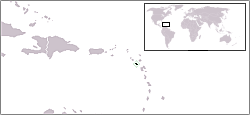 Montserrat (pronounced /mɒntsəˈræt/) is a British overseas territory located in the Leeward Islands, part of the chain of islands called the Lesser Antilles in the Caribbean Sea. It measures approximately 16 km (10 miles) long and 11 km (7 miles) wide, giving 40 kilometres (25 mi) of coastline.
Montserrat (pronounced /mɒntsəˈræt/) is a British overseas territory located in the Leeward Islands, part of the chain of islands called the Lesser Antilles in the Caribbean Sea. It measures approximately 16 km (10 miles) long and 11 km (7 miles) wide, giving 40 kilometres (25 mi) of coastline.
Christopher Columbus gave Montserrat its name on his second voyage to the New World in 1493, after Montserrat mountain located in Catalonia. Montserrat is nicknamed the Emerald Isle of the Caribbean, both for its resemblance to coastal Ireland and for the Irish descent of its inhabitants.
Its Georgian era capital city of Plymouth was destroyed and two-thirds of the island’s population were forced to flee abroad by an eruption of the previously dormant Soufriere Hills volcano that began on July 18, 1995. The eruption continues today on a much reduced scale, the damage being confined to the areas around Plymouth including its docking facilities and the former W.H. Bramble Airport the remnants of which were buried by flows from volcanic activity on February 11, 2010.
An exclusion zone extending from the south coast of the island north to parts of the Belham Valley has been imposed because of the size of the existing volcanic dome and the resulting potential for pyroclastic activity. At present (June 2010) visitors are not permitted entry into Plymouth, but an impressive view of the destruction can be had from the top of Garibaldi Hill in Isles Bay.
The village of Brades currently serves as the temporary centre of government while construction proceeds on a new town at Little Bay in the north of the island, out of reach of further volcanic activity.

Notes from Wikipedia








